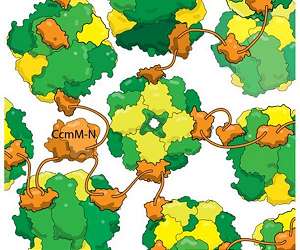Imagine taking your favorite treat – a Mars bar or cream puff – and beaming it with X-rays to map out what makes it so delicious. Then, picture being able to transfer some of those magnificent qualities and tastes to healthier, more sustainable products.
Such a fantasy could become reality if the Small Angle X-ray Scattering method is used, known as SAXS. By using X-rays, SAXS makes it possible to study food at the nanolevel, where a nanometer equals one millionth of a millimeter.
SAXS has yet to be widely deployed for food research, but the the University of Copenhagen’s Department of Food Science is working on the method and has acquired a new Nano-inXider instrument that uses X-ray radiation to examine foodstuffs, among other things.
The method has great potential in relation to the foods of the future, says Jacob Kirkensgaard, an associate professor at the University of Copenhagen’s Department of Food Science, as well as at the Niels Bohr Institute. Kirkensgaard uses SAXS equipment in his research, where he collaborates with the Department of Pharmacy and Lund University.
“SAXS can be used to optimize the development of foodstuffs in relation to their taste, texture and nutritional content. For example, when we look at the structure and function of foods at the nanolevel, we could improve their design so that they break down in such a way that as many nutrients as possible are absorbed. In this way, we can help prevent obesity and improve health,” he says.
Can make plant proteins easier to eat
SAXS can also be used to make our foods more sustainable, explains Professor Lilia Arhne of the University of Copenhagen’s Department of Food Science.
Together with Jacob Kirkensgaard, she used the SAXS method to study how milk proteins behave in various sustainable processing methods.
“Our knowledge of how milk components give a special taste, mouthfeel and texture can be used for research into plant-based proteins. Because, if we can map out exactly what it is that makes milk nourish us, feel soft in the mouth and taste sweet and salty, we could copy those properties into new plant-based products that are easier on our climate, which would help get more people to consume them,” she explains.
The two researchers have already met with great interest from Danish industry in relation to how the SAXS method can make it easier to produce tasty plant proteins.
“Recently, we met with a range of large Danish food producers and ingredient suppliers. They are particularly curious about how they can make delicious plant-based foods, without compromising taste and structure,” says Jacob Kirkensgaard.
He underscores that the development of new sustainable and innovative foodstuffs depends on our being able to understand and analyse the structure of individual products.
“As such, the University of Copenhagen’s commitment to the SAXS method is interesting. We certainly hope that industry embraces it,” concludes Jacob Kirkensgaard.
Related Links
University of Copenhagen – Faculty of Science
Farming Today – Suppliers and Technology
|
We need your help. The SpaceDaily news network continues to grow but revenues have never been harder to maintain. With the rise of Ad Blockers, and Facebook – our traditional revenue sources via quality network advertising continues to decline. And unlike so many other news sites, we don’t have a paywall – with those annoying usernames and passwords. Our news coverage takes time and effort to publish 365 days a year. If you find our news sites informative and useful then please consider becoming a regular supporter or for now make a one off contribution. |
||
|
SpaceDaily Contributor $5 Billed Once credit card or paypal |
SpaceDaily Monthly Supporter $5 Billed Monthly paypal only |
|

![]()
Fickle sunshine slows down Rubisco and limits photosynthetic productivity of crops
Urbana IL (SPX) Jan 21, 2022
All of the carbon in our bodies, in food, and in the entire biosphere, results from the assimilation of carbon dioxide in photosynthesis by a single enzyme, known to biologists as Rubisco. Not surprisingly, given its importance, this protein is the most abundant in the world. Researchers from Lancaster University are working to improve the sustainable productivity of key crops in sub-Saharan Africa have discovered a new imperfection in the way Rubisco functions in cowpea and believe this imperfection is … read more